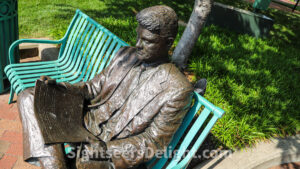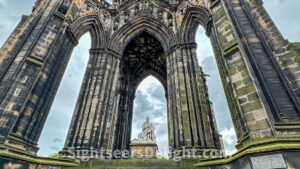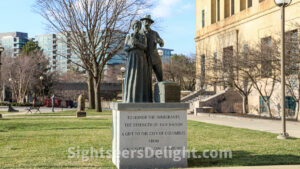Clarksville firefighter and sculptor Scott Wise created “The Day After,” also known as “The Seated Piece.” Main Street Clarksville commissioned the public art, the group’s last. The statue’s title refers to January 23, 1999, the day after a tornado struck downtown Clarksville. The statue, described by the artist as “Joe Public,” is reading a replica of the January 23, 1999 edition of The Leaf-Chronicle newspaper, which is located across Commerce Street from the statue. The statue was formally unveiled on October 30, 2003, and Main Street Clarksville donated it to Montgomery County after its unveiling.
37040
The Doughboy statue on display in downtown Clarksville dates to 1929. It features an American soldier holding a grenade in one hand and a rifle in the other and honors the soldiers who fought in World War I. For more than 40 years, it stood guard in front of Clarksville High School and was moved to the armory on Ft. Campbell Boulevard in 1972. On April 15, 2010, city and civic leaders rededicated the statue at its new location in front of the Transit Station on Legion Street in downtown Clarksville. In 2015, it moved to a new location at the Tennessee State Veterans Home.
The Chicago Picasso (often just The Picasso) is an untitled monumental sculpture by Pablo Picasso in Daley Plaza in Chicago, Illinois.
60602
The Southern Provinces Romney Breeders Club erected The Romney Statue in Gore, New Zealand, in recognition of the importance of the sheep bred to the country’s meat and wool industry. K.A. Bain, president of the New Zealand Romney Sheep Breeders Association, unveiled the statue on July 2, 1991. Messrs. Bennett and Young first imported the Romney sheep to New Zealand, reaching Wellington in 1843. New Zealand Romney sheep comprise more than half of New Zealand’s 40 million sheep.
The Columbus Italian Club commissioned this sculpture, created by Gary Ross, in 1992. The statue is on display in Battelle Riverfront Park along the Scioto River.
The Tomb of the Unknown Revolutionary War Soldier honors the soldiers who died during the American Revolutionary War. Many of those soldiers were buried in mass graves in Washington Square, where the monument is located. The memorial was conceived in 1954 by the Washington Square Planning Committee and completed in 1957. The monument, designed by architect G. Edwin Brumbaugh, features an eternal flame and a bronze cast of Jean Antoine Houdon’s George Washington statue. An unknown soldier — either British or a colonial soldier — is encased in the memorial. Both the tomb and Washington Square are part of Independence National Historical Park.
19106
The Torch of Friendship is a monument on Biscayne Boulevard in Downtown Miami, Florida, at the northwest corner of Bayfront Park. It was built in 1960 to signify the gateway for immigrants coming from Latin America and the Caribbean to the United States of America. The flame was intended to act as a welcoming beacon for both old and new immigrants to the nation. In 1964, it was re-dedicated in memory of President John F. Kennedy following his assassination.









